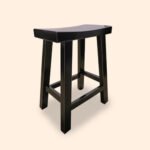Furniture is an everyday necessity, but also a form of craftsmanship. When decorating our house, we do not have in mind the use of stools as decorative furniture. What if I told you that it can help you have more versatile spaces and take advantage of every corner of your home?
The stool of oriental origin is perfect to be stored anywhere and to have it on hand for unexpected visits. It works well with any décor, such as a nightstand, a complementary living room table, or even as a support for your favorite plant.
Still not sure if it’s worth a try? Well, here we tell you its story so that you will be a little more in love with this perfect oriental piece of furniture.
The oldest seat in the world

Although it has become popular in the easternmost area of the planet, the truth is that the stool does not originate there.
The stool was born in Mesopotamia, when it was 1600 BC. This small object was made of wood and covered with skins or cushions to alleviate the hardness of the material. Also spread throughout Egypt, the stool began to be used by people of importance such as kings or reserved for the gods.
At that time, the legs of the stools were shaped like the claws of a lion or panther, as symbols of the supreme power of those who occupied them. Strong and fine woods such as ebony, olive, cedar or pine, were carved and ornamented with ivory and gold. The Egyptians took this fixed seat further and invented in 2000 BC, a comfortable and collapsible structure to be transported.
Already in the East and before the Ming dynasty began (1368 – 1644), the Orientals used to sit on the ground on mats made of natural materials, with their legs crossed. Therefore, the evolution towards the first raised seats arose thanks to the influence of foreign customs.
The first low platforms were used as honorary seats for high officials and religious dignitaries, during ceremonial and sacrificial rites. Later on, chairs, stools and benches began to be used at all levels of society and not just among the elite. Sitting on the ground is no longer customary for Eastern culture.
During the Ming dynasty, the development of ancient oriental furniture was consolidated. Furniture design became a true art form outside of its utilitarian function. Meanwhile, the stool traveled through Italy, Spain, England, Austria, France, the United States, Germany, Russia and many others.
Thus, it is not surprising that such elegant and useful pieces return to our homes in the 21st century. Thanks to the evolution of the stool in different regions, it is possible to find them today carved with beautiful landscapes and traditional motifs, representing the culture of each region.
Its evolution
The techniques of making Ming furniture revealed great skill. Cabinetmakers used circular and square shapes, with thick or thin motifs and contrasting lines. All these characteristics made up the unique structure of oriental crafts.
The pieces were assembled without visible joints, providing natural and fluid contours. Surfaces are wax polished to make them shiny, smooth and clean, revealing their natural beauty. In addition, they used extensive ornamental materials that gave the touch of elegance that every house needs.
The stool, in itself, has evolved little. However, when the stool was backed, the chair was born and when the chair had armrests, it became an armchair. The stool is currently manufactured faster and in a less rustic way, but very similar to the old ones, standing out for its uniform colors, its solidity and elegance.
For now, the characteristics that stand out the most in it are its three or four legs, its ability to move around and its natural freshness implied by inspiration or carving in oriental culture. Although it lacks a back and armrests, this makes it a piece of furniture with many more uses and greater acceptance among the public.
For what and who?
Oriental stools were perfect when women wore their dresses large. In this way they avoided wrinkles in their dresses. If a guest came home unexpectedly, they could occupy the stool and then put it away or hide it under the table. Likewise, it was used as a support to rest the feet so, after our long days, it would be ideal to have one at home.
But like the stool, we evolve. This object began to be occupied in all homes, by all people and things. Today’s oriental stools can be found accompanying kitchen islands, in living rooms, bedrooms, patios, garages and even bathrooms.
Although in the ancient East they were used to decorate the traditional courtyards of the upper class, now oriental stools are available to everyone. They are acquired to place things and have them at hand, indoors and outdoors, as side tables, as a seat, but always adding an oriental touch to our home.
Stools in Martinica Collection
Our Den Shin stool is the perfect complement to your home. Its narrow shape and curved surface give it the comfort and elegance that your favorite corners need. It is a unique piece, with which you will infuse your home with a traditional essence.

Summary
Martinica Collection wants you to bring the best of oriental culture to your space. We have thought that oriental stools are a perfect way to start. As you can see, they are the perfect wildcard to solve the little space at home or if you want to give a spin to their use and get the creativity that you carry inside.
Fill your home with history, craftsmanship and originality with our Den Shin stool, a unique ornamental piece that you will get a lot out of. I invite you to visit our website to fall in love with all the other pieces!

